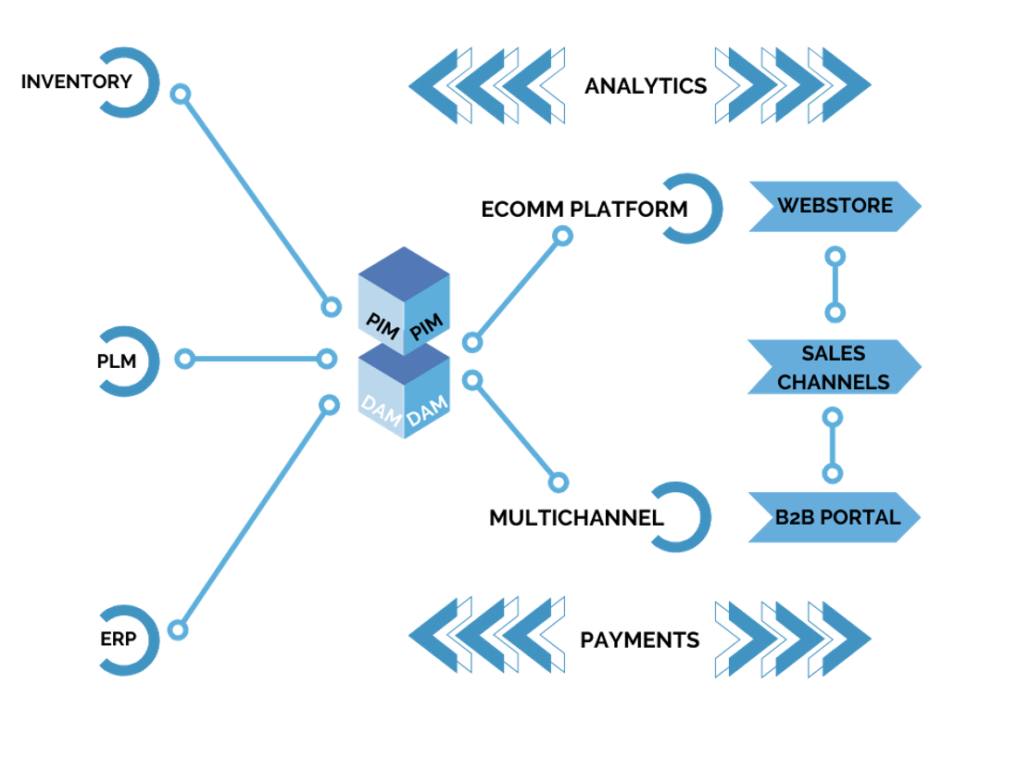What Is Model Context Protocol (MCP)?
Model Context Protocol (MCP) is a framework for structuring product data and its contextual relationships so AI agents—like ChatGPT, Amazon Rufus, or Google Gemini—can interpret...
Published: Jul 25, 2022 Updated: Dec 18, 2024
Online shopping experiences go far beyond finding a product, adding it to the shopping cart, and checking out. Modern consumers are looking for personalized and immersive product experiences fueled by quality product data. As such, personalization in eCommerce must always be front of mind for online retailers. That’s where Product Experience Management (PXM) makes an entrance. Read on to get a full understanding of the connection between PIM and PXM.
The PXM definition is when you take everything you know about your products and your customers to craft personalized experiences across all touchpoints. It’s a data-driven approach that enables you to create shoppable experiences that provide each customer with the right information at the right time. Therefore, you’ll use a variety of tools and technologies to ensure each online experience is different depending on the customer.

Product Experience Management spans the entire shopping journey. From when customers carry out product searches, right through to the checkout, you’ll be delivering contextualized product information. This contextualized product information will be based on a variety of factors, such as:
Using this information, coupled with quality product data, you will create completely personalized product recommendations. To do this, digital retailers will usually have variations of their product data and digital assets that resonate with their different customers based on the factors listed above. In turn, this will lead to improved customer loyalty, higher conversion rates, and greater market share.
Overall, Product Experience Management (PXM) is reliant on:
This includes all aspects of your product data, including digital assets, product descriptions, materials, colors, and more. You need to enrich product data for every stage of the buyer journey, so customers have the best possible experience as they search, shop, and buy.
This is where you need to take into account the factors we listed above. Base it on your customer, the channel they’re using, and how they are or have previously interacted with your product. From there, you can adapt and optimize the data to meet their needs and expectations.

The importance of customer experience is constantly on the rise, so you’ll need to regularly re-evaluate all factors that affect buying decisions. From this evaluation, you will gain actionable customer insights, enabling you to make continuous improvements to guarantee the best possible experience.
Many aspects of a PXM tool are reliant on you having quality product data – and lots of it. So, it’s unsurprising that Product Information Management (PIM) solutions are becoming an indispensable tool in digital commerce.

PIM is a centralized hub for all your product information and digital assets. Gather, store, manage, enrich, and distribute everything to your various sales channels from a single location. The main advantage of having a PIM system in place is being able to create a golden record for your product catalog. You also have massive storage capabilities, meaning you can store multiple versions of product descriptions and imagery against a single SKU.
In addition, there are also powerful integrations that give you the power to serve tailored product details to your audience based on key PXM factors. Overall, this means you’re always delivering the best product experiences. In summary, this is why there’s such a deep-rooted connection between PIM and PXM, which we’ll expand on now.
The concept of Product Experience Management has been around for many years. Creating memorable buying experiences is essential for increasing sales. But as personalization has become more important for eCommerce, PXM has emerged as a popular marketing tactic. Consequently, vendors are using the acronym to differentiate themselves.

So, the basic idea behind PIM and PXM is fundamentally the same. Both processes involve personalizing data to create richer experiences for customers. What’s more, many PIM features provide a deep level of personalization.
In addition, PIM will localize product data for buyers in different countries. This involves translating product descriptions into the different languages of the markets you serve. From a personalization perspective, localization is great for tailoring products to a specific customer in a specific location. It is also good for product management and digital asset management.
The experience can be bolstered further by incorporating high-res photos or videos. Therefore, you should consider altering the digital assets you display based on the consumer’s personal needs and preferences. The end result is a product experience that provides the right information, in the right format based on what your customer is looking for.

Another aspect of personalization in PIM software is scoping. You can tailor product experiences for different marketplaces e.g. B2B and B2C. For instance, you can scope data to fit the technical language specifications of B2B buyers. If you’re selling to B2C consumers, you could scope your product descriptions to feature more emotive language.
“PXM isn’t PIM 2.0. It’s PIM in collaboration with other tools and technologies such as in-depth analytics, and Artificial Intelligence (AI). If you’re going down the experience management route, you need to have data from sources that aren’t available in what we’d consider PIM information.”
Pimberly Pre-Sales Consultant
Product Information Management (PIM) and Product Experience Management (PXM) are closely linked but serve different functions in the eCommerce ecosystem. PIM is primarily concerned with collecting, storing, and organizing product data in a central system. It ensures that businesses have accurate, consistent, and comprehensive product information, such as specifications, images, descriptions, and digital assets. PIM systems enable retailers to manage large volumes of product data and make it easily accessible for distribution across various sales channels.
On the other hand, PXM takes the product data provided by PIM and transforms it into personalized, engaging experiences for customers. PXM focuses on how to present the right product information to the right customer at the right time. It uses customer data, such as demographics, browsing history, and preferences, to tailor the shopping experience. While PIM provides the data foundation, PXM utilizes this data to create a customized and contextualized experience across all touchpoints, from search results to product recommendations and checkout.
In essence, PIM ensures that businesses have high-quality and organized product information, while PXM takes that information and personalizes it to meet individual customer needs, driving higher engagement and conversions. Both PIM and PXM work together to optimize the customer journey and deliver seamless, data-driven shopping experiences.
From a selling perspective, an awesome PIM solution is vital for high-quality PXM. Rather than being a separate system, think of PXM as an outward result. PIM is what you use to enrich product data. Instead, product experience management is how you stage the experience.

Customer information, logistics, and stock data are important as well. Essentially, you want to find out as much as you can about your customers. Find out what customers have previously ordered from your store and if anyone else has ordered similar products.
With this wealth of data, you can learn how to target your products to specific people when they visit your site or sales channels. So, not only will you have richer product data in PIM, you’ll also be creating the personalized shoppable content they crave.
PXM is here to stay, and many product teams are already using PIM and PXM software in tandem to refine their personalization strategies. That’s because both these technologies have the functionalities needed to generate engaging customer experiences.


